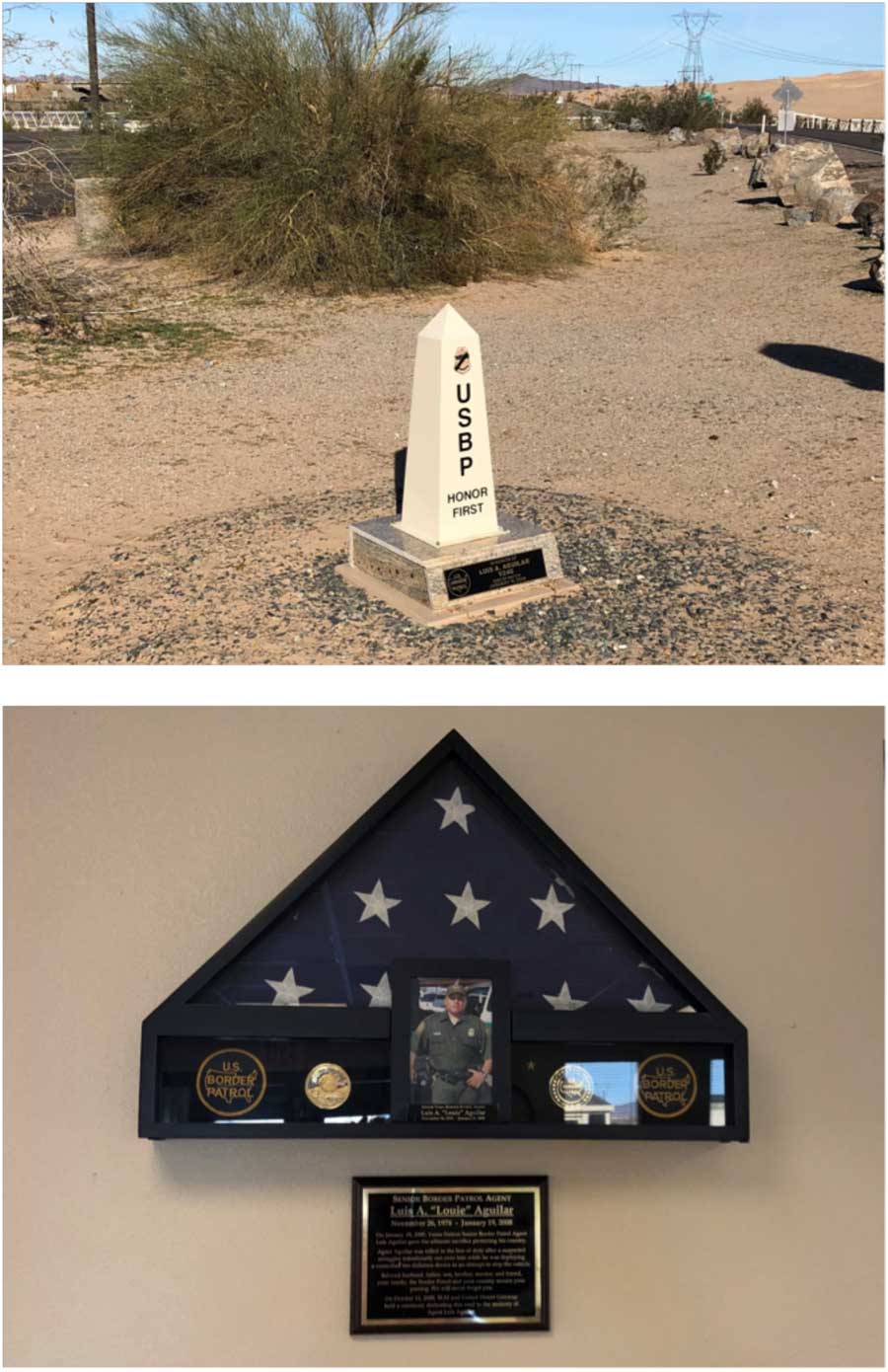
by an obelisk, and a memorial in the Ranger Station honors
him.
During my recent border tour of western Arizona and eastern California, I came upon a monument to Senior Border Patrol Agent Luis Aguilar. Agent Aguilar was killed on January 19, 2008, by the driver of the vehicle he was attempting to stop in front of the Buttercup Ranger Station in the California Imperial Sand Dunes just west of Yuma, Ariz. That incident could likely have been prevented had the wall, which was started at the San Luis, Ariz., Port of Entry in 2006 and subsequently extended to just south of the Buttercup Ranger Station along the border with Mexico, been there at the time. (It was completed in 2010.)
As the U.S. Customs and Border Protection website describes the events of that morning:
On Saturday, January 19, 2008, Senior Patrol Agent Luis A. Aguilar of the Yuma Station was murdered while in the performance of his duties.
Agent Aguilar was attempting to deploy a set of tire deflation devices to stop a suspected smuggler who was attempting to evade agents and escape into Mexico across the Imperial Sand Dunes in the Yuma Sector area of operations. The suspect, driving a Hummer, accelerated his vehicle and intentionally swerved into Agent Aguilar. Agent Aguilar was unable to avoid the oncoming vehicle and was struck by the suspect's vehicle. Despite efforts by his fellow agents and responding EMS, he died at the scene as a result of his injuries.
The National Border Patrol Museum website notes:
The suspect was subsequently arrested in Mexico and extradited by Mexican officials to face trial in the United States. He was convicted of 2nd Degree Murder in the United States District Court, Southern District of California and sentenced to life in prison.
That fact is likely cold comfort to the wife and two children Agent Aguilar left behind.
The road in front of the station is dedicated to him. Aside from that, his killing has largely been forgotten, one more tragic death in the line of duty for a group of agents who do a dangerous job few other Americans would dare to take.
I would like to report that I deliberately drove to this isolated area in order to understand what happened that January morning. In fact, however, I happened upon the site coincidentally: None of the locals to whom I had spoken previously had mentioned the incident, although I was seeking information about the border and the barriers that protect it.
The Imperial Sand Dunes are largely today a recreational area. As the Bureau of Land Management describes them:
Located in the southeast corner of California, the Imperial Sand Dunes are the largest mass of sand dunes in the state.
Formed by windblown sands of ancient Lake Cahuilla, the dune system extends for more than 40 miles in a band averaging 5 miles wide. Dunes often reach heights of 300 feet above the desert floor, providing outstanding opportunities for recreation. A favorite place for off-highway vehicle (OHV) enthusiasts, the dunes also offer fabulous scenery, opportunities for solitude, and a home to rare plants and animals.
According to the locals with whom I spoke, however, before the wall was erected vehicles carrying drugs and migrants would traverse the steep dunes in order to gain access to Interstate 8. Once on I-8, assuming that they weren't detected at entry, those vehicles were then free to move within the United States. That traffic has largely been stopped.
Then-Acting Homeland Security Secretary Elaine Duke alluded to this traffic in an opinion piece that appeared in USA Today in August 2017:
For years, Yuma sector was besieged by chaos as a nearly unending flood of migrants and drugs poured across our border. Even as agents were arresting on average 800 illegal aliens a day, we were still unable to stop the thousands of trucks filled with drugs and humans that quickly crossed a vanishing point and dispersed into communities all across the country.
It is hard for anyone familiar with Yuma sector today to imagine this scene. That's because nearly a decade ago, a group of bipartisan lawmakers came together to protect the homeland, save innocent lives, and build a physical barrier across the border.
We built new infrastructure along the border east and west of the San Luis Arizona Port of Entry in 2006. The existing fence was quickly lengthened, and we added second and third layers to that fencing in urban areas. Lighting, roads and increased surveillance were added to aid agents patrolling the border.
Although there is still work to do, the border in Yuma sector today is more secure because of this investment. Even under lax enforcement standards, apprehensions in fiscal year 2016 were roughly a 10th of what they were in FY 2005 — and are on track to be even lower this year. Crime has significantly decreased in the Yuma area, and smugglers now look for other less difficult areas of the border to cross — often areas without fencing.
Better border security, including barriers where smugglers can easily cross into the United States, do more than just curb the traffic of aliens and drugs entering this country illegally; they can help to protect the lives of those who protect us.
